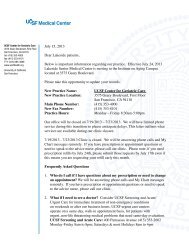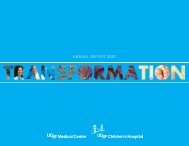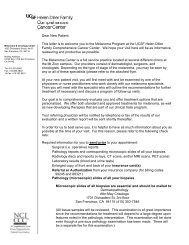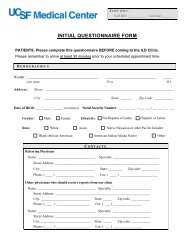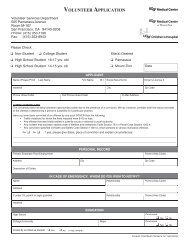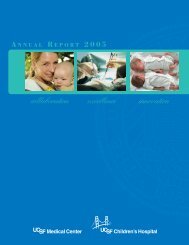c e n t e r n e w s l e t t e r - UCSF Medical Center
c e n t e r n e w s l e t t e r - UCSF Medical Center
c e n t e r n e w s l e t t e r - UCSF Medical Center
You also want an ePaper? Increase the reach of your titles
YUMPU automatically turns print PDFs into web optimized ePapers that Google loves.
(NEWS FROM THE RESEARCH FRONT CONTINUED)<br />
with HER2+, metastatic breast cancer, previously treated with an anthracycline, taxane, and trastuzumab with<br />
either capecitabine alone, or capecitabine with lapatinib. Women who received the combination had better<br />
tumor shrinkage, and their disease was controlled for longer than the women who received capecitabine alone<br />
(8.4 months compared to 4.4 months). There was no difference in how long the women lived after starting<br />
treatment, but less women developed brain metastases during the study treatment. The combination was pretty<br />
well tolerated; the main side effects are diarrhea and a mild skin rash.<br />
What does this mean for patients with HER2+ breast cancer? Lapatinib is an oral medication, and it offers<br />
another treatment option for this aggressive disease. So far, it appears that lapatinib may have fewer side effects<br />
on the heart, and there is interest in understanding the mechanisms of resistance (tumor growth) to trastuzumab<br />
to see if lapatinib can be effective for these hard to treat cancers. Lapatinib will be tested in early stage, HER+<br />
breast cancer in combination with trastuzumab or alone both before and after surgery to see what approach works<br />
better; both drugs will be given with standard chemotherapy In metastatic or advanced cancer, lapatinib is being<br />
tested in a number of ways. At <strong>UCSF</strong> we have tested lapatinib in combination with the anti-angiogenic drug bevacizumab<br />
(Avastin); our early data suggests that this is a very effective combination treatment. In addition, we have<br />
an exciting new study that has just opened that is evaluating increasing doses of lapatinib alone, as data from the<br />
laboratory of our colleague, Dr. Mark Moasser, suggests that higher doses could be effective even in very unresponsive<br />
cancers. Lapatinib is also being tested as a treatment for women with brain metastases.<br />
NO BENEFIT FROM TAXOL? WHAT DOES IT ALL MEAN???<br />
On October 11, 2007, Dr. Dan Hayes and his collaborators from a national clinical trials study group that includes<br />
<strong>UCSF</strong>, called the CALGB, published a paper in the New England Journal of Medicine. On that same day, headlines<br />
across national newspapers and the internet made bold (and misleading) statements such as “Chemotherapy<br />
is not useful in most patients”. What did this data mean and how does it impact treatment?<br />
CALGB 9344 was a national clinical trial published in 2003, which randomized 3121 women with early<br />
stage breast cancer that had spread to the lymph nodes to the chemotherapy treatment doxorubicin<br />
(adriamycin) and cyclophosphamide (cytoxan, called ‘AC’) with or without paclitaxel (Taxol) following<br />
primary surgery. Adding paclitaxel to AC improved outcome; women had less recurrences and lived<br />
longer. This treatment became the standard of care for higher risk early stage breast cancer following<br />
its initial presentation in the late 1990’s. Subsequently, it was found that giving the chemotherapy<br />
every two weeks was more effective than the previous standard of every three week dosing.<br />
In this new study, the stored tumor samples from patients who participated in the study were tested<br />
for estrogen and progesterone receptors (ER, PR) as well as HER2. The study found that there was<br />
a big difference in response to paclitaxel based on these tumor characteristics. Patients with tumors<br />
that were either HER2+ or ER and PR negative appeared to derive a big benefit from receiving paclitaxel,<br />
but patients with ER or PR positive cancers that were also negative for HER2 did not seem to<br />
benefit at all. This data actually fits in nicely with much of what we understand about the effects of<br />
chemotherapy – which works generally better in fast growing aggressive cancers compared to slow<br />
growing cancers. In addition, hormone therapy is tremendously effective, so when it works well,<br />
chemotherapy may add very little in terms of preventing cancer recurrence.<br />
So what do we do? It is clear that some ER or PR positive cancers do benefit from AC followed by<br />
paclitaxel, so now we have to figure out which ones. It may be that treatment with paclitaxel, or its<br />
sister drug docetaxel (Taxotere) may be just as good or better, and we may be able to avoid the use<br />
of AC in many patients in the future. How are we going move forward? Tests that can evaluate the<br />
gene expression may help us a lot – one study has looked at the ability of the cancer genes to predict<br />
the benefit of chemotherapy added to tamoxifen! The large national trial called ISPY, run by Laura<br />
Esserman, has collected tumor biopsies during chemotherapy before surgery, and will give us a lot of<br />
information about the benefit of chemotherapy, as well as specific types of chemotherapy, in the treatment<br />
of subsets of breast cancer. For now? We have to tailor our treatment recommendations based on<br />
our best understanding of cancer biology. That means that some hormone receptor positive cancers will<br />
still be best treated with AC followed by paclitaxel, but other options must be considered as well.<br />
BREAST CARE CENTER NEWSLETTER • SPRING 2008 • page 3





